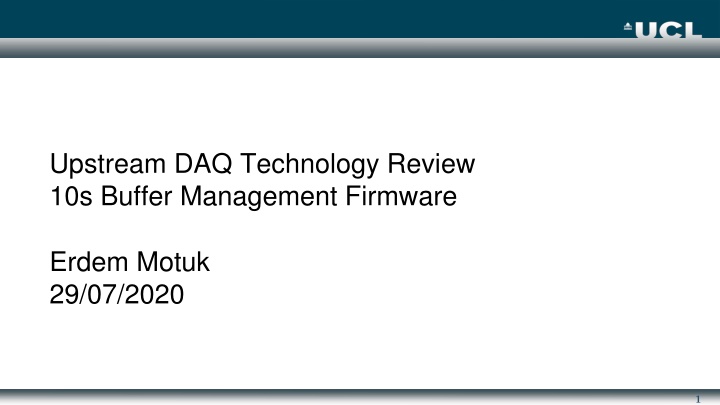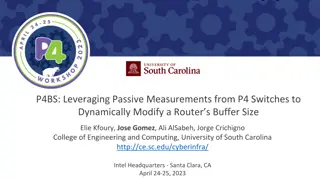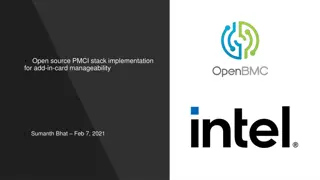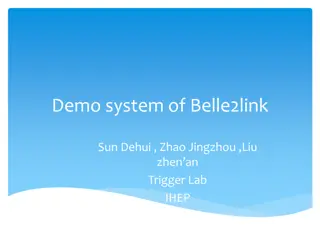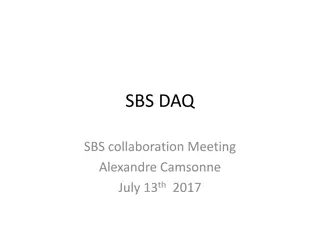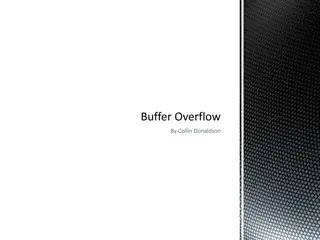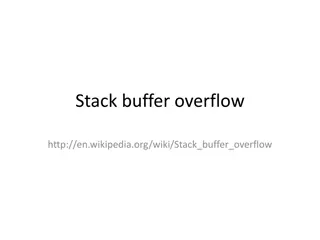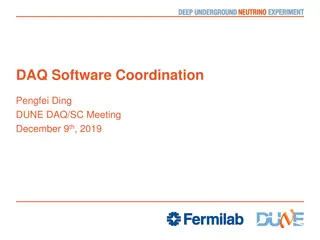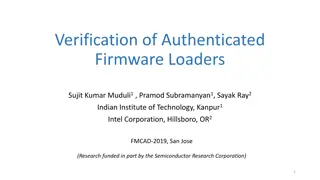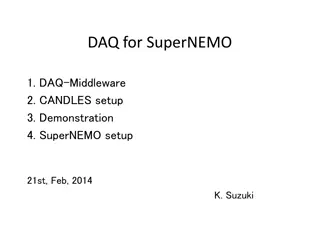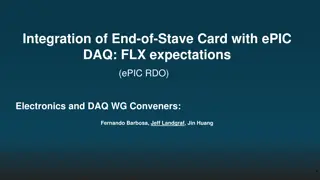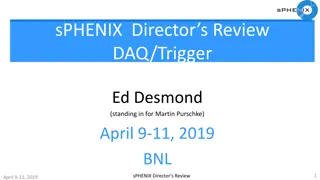Upstream DAQ Technology Review: 10s Buffer Management Firmware Overview
This content provides an in-depth look at the firmware structure, system-level view, compression scheme, performance evaluation, and decompression tools related to the Upstream DAQ Technology Review. It covers aspects such as memory management, implementation details, resource usage, and integration with other modules. The content delves into how the compression module meets its constraints and the development of decompression routines for validation purposes.
Download Presentation

Please find below an Image/Link to download the presentation.
The content on the website is provided AS IS for your information and personal use only. It may not be sold, licensed, or shared on other websites without obtaining consent from the author.If you encounter any issues during the download, it is possible that the publisher has removed the file from their server.
You are allowed to download the files provided on this website for personal or commercial use, subject to the condition that they are used lawfully. All files are the property of their respective owners.
The content on the website is provided AS IS for your information and personal use only. It may not be sold, licensed, or shared on other websites without obtaining consent from the author.
E N D
Presentation Transcript
Upstream DAQ Technology Review 10s Buffer Management Firmware Erdem Motuk 29/07/2020 1
Outline System-level view Compression block presentation (from Pip Hamilton) Description of the firmware structure Description of the inputs and outputs Description of the firmware sub-modules Current software interfaces for test and debug Implementation results and performance figures Current limitations Integration with other modules To-do list 2
Compression Overview The compression scheme we are using is Fibonacci encoding, using the Fibonacci sequence as a base . e.g. 101011 = 1 + 3 + 8 = 12 1 2 3 5 8 Extra 1 signals end of word: code words always end uniquely in 11 . Encoded number is length i+1, where i = index of largest Fibonacci number smaller than input. Should be able to deliver required compression factor C > 2 (likely closer to 3). Firmware Implementation 03/03/2025 Pip Hamilton 4 Can be toggled on (default) or off (debug mode, incompressible data)
Performance / Resource Use A complete v.0 of the compression module has been written, simulated and synthesised. It meets its constraints for timing and resource usage (most demanding requirement being block RAM usage) Compression factor delivered currently under assessment. Timing Worst Negative Slack 1.048 ns Resource Usage (ZU9EG ZCU102 board FPGA) Worst Hold Slack Worst Pulse Width Slack 1.458 ns 0.016 ns CLB LUTs 213/274080 (0.1%) CLB Registers 337/548160 (0.1%) Block RAM 337/912 (37%) 03/03/2025 Pip Hamilton 5
Decompression Tools to parse and decode the output of the compression have also been written for validation purposes: these are easily adaptable for use as part of the software chain. Initial implementation of on-line decompression routine (Dave Newbold) ~ 80MByte/s per core. 03/03/2025 Pip Hamilton 6
10s Buffer management firmware block diagram DDR4 RAM XILINX MIG 512-bit data From the compression block Write Interface Super Packet Formatter AXI4MM signals Xilinx AXI4MM Smart Connect 40x 16-bit AXI4S Read address AXI4 Memory Mapped Interface Address of super-packet Event Fragments 128-bit at 300 MHZ Super-packet Indexer Read Interface Output Selector AXI4S to NVME Supernova data 256-bit at 300 MHz Supernova Trigger Time-stamps Time-stamps Command FIFO Event Fragment Requests AXI4 memory interface handles the transition from AXI4 streams to AXI4 memory mapped access to the MIG. 8
Inputs to the buffer management block From the compression block Compressed super packets , each carrying 64 12-bit ADC samples from 64 wires, compressed on to a variable number of 16-bit words Each super packet comes in a dedicated input link (pipeline) to the block 40 of these links corresponding to a total of 2560 wires form the inputs to the block The inputs follow the AXI4-stream format that we use for the Upstream-DAQ firmware 16-bit words at each clock cycle with extra signals indicating valid data, start and end of the packet, flow-control etc. Payload Payload Flags Timestamp Timestamp Timestamp Timestamp Link 0 Flags Timestamp Timestamp Timestamp Timestamp Payload Payload Link 39 9
Inputs to the buffer management block From event selection These are named as event fragment requests in the block diagram form the trigger command Follows the AXI4-stream format with 16-bit words at each clock cycle (250 MHz) Trigger command ID followed by the trigger start time and trigger end time Inputs to the buffer management block From supernova trigger This starts reading the compressed wire data from the DDR4 memory to the NVME interface NVME interface forms the 100-sec supernova storage buffer A write to an IPBus register to start Number of ADC samples to read for the supernova trigger is configurable (at the moment for test purposes via an IPBus register) 10
Outputs from the buffer management block Event fragments These correspond to the data read from the DDR4 RAM as responses to the event fragment requests These follow the AXI4-stream format with 128-bit words at each clock cycle (300 MHz) The command ID of the event fragment request is placed at the start along with the other header information Outputs from the buffer management block Supernova trigger data These correspond to the data read from the DDR4 RAM as responses to the supernova triggers These follow the AXI4-stream format with 256-bit words at each clock cycle (300 MHz) 11
Detailed description of the firmware Super-packet formatter Extra header information added to each super-packet DDR4 clk 16-bit AXI4S Input FIFO 16x4096 Magic no./ Length AXI4S clk (200 - 250 MHz) Magic word BEEF Length Link No. CAFE 512-bit data Flags Timestamp Timestamp Timestamp Stream FIFO 512x128 64-bit data / wr_en Read pointer Timestamp Payload Payload MUX Payload Flow ctrl DDR4 clk 16-bit AXI4S AXI4S clk (200 - 250 MHz) Input FIFO 16x4096 write-run end signal Memory interface block Magic no./ Length Length, Super-packet write-run indicator Initial timestamp DDR4 write address corresponding to a write-run Super-packet Indexer Mux operates in a round-robin fashion makes sure that all super-packets corresponding to the same time period is written consecutively to the DDR4 memory Writing the data from the super-packets from all 40 links corresponding to the same time period is named as a write-run 12
Detailed description of the firmware Memory Interface 512-bit read data and valid to the output control module and supernova buffer interface Block diagram and the important AXI4 memory mapped signals of the DDR4 write and read interface. Multiplexes super-packet data writes and supernova and event selection request reads Writes and reads are performed in 4 KByte chunks in order to efficiently use the DDR4 access bandwidth and optimise the write/read latencies (exception is at the end of a write- run data could be less than 4 KByte) The address information from the super-packet indexer is required to generate the read signals. For the write case the module calculates the write signals (address, length, strobe). When the memory is full the write address rolls over to the beginning. Circular buffer. 512-bit data AXI WRITE CHANNEL Write-run start/end Read/Write pointers Write Interface AXI RESPONSE Supernova read start / no.of samples AXI4 Memory Mapped Interface Event selection read start Start/End addresses AXI READ CHANNEL Read Interface AXI READ RESPONSE 13
Detailed description of the firmware Super-packet Indexer Super-packet indexer holds the write addresses corresponding to the beginning of each write-run (40 super-packet links) Initial timestamp is written at the very beginning of the buffer storage operation The current size of the index RAM is 32x16384 16K address entries Upon an event selection request, the start and end timestamps of a trigger command is sent to the indexer Indices of the start and end read addresses are calculated These indices are read, and the resulting addresses are sent to the memory interface Ctrl block Trigger command valid Memory read request Memory read addresses Start/End timestamps Initial timestamp Index RAM Write-run write address Write-run finished signal 14
Detailed description of the firmware Output selector The event fragment output selector detects the magic word from the incoming DDR4 data to detect a super- packet The timestamp is compared against the start and end times from the current event selection command Each sub-block has their own FIFOs for the incoming data flow ctrl signals are generated to provide backpressure As a result in the extreme cases loss of data can occur old data is written over without being read Trigger command valid Start/End timestamps Event fragment stream Event fragment selector Data read from DDR4 Data valid from DDR4 Flow ctrl for event frag. sel. Flow ctrl for supernova sel. Supernova buffer stream Supernova trigger on Supernova data selector 15
Extra firmware blocks for test and debug DDR4 RAM Sink for the event fragments XILINX MIG Event fragments IPBus interface IPBus interface Super Packet Format ter Write Interface Input Data Generator AXI4MM signals AXI4MM Smart Connec t Block RAM AXI4 Memory Mapped Interface Superpackets Super-packet Indexer Read Interface Output Selector Supernova trigger data Event selection command generator IPBus interface AXI4S to NVME Event selection packet Command FIFO The input data generator block generates the super-packets from an initial timestamp. For each super-packet run the timestamp is incremented by 64 The data is a counter counting from 0 to payload length For verifying correct write/read operation Event selection command generator generates an event selection packet from IPBus writes The sink takes a snapshot of the output in a RAM to be read by IPBus 16
Software Interfaces Current IPBus registers for debug: Initialise data send : Starts sending the data to be written to the DDR4 memory. The data is generated in the raw data packet format and has a counter for ADC samples. 40 channels of data exist each corresponding to a super packet. Number of packets to be sent : This sets the number of super packets to be sent to the buffer management block. Event selection command generate : These registers are used to generate the event selection command. There is a register for command ID, trigger start time and trigger end time. Event selection command issue : This starts sending the event selection command generated. Input FIFOs enable : This enables the FIFOs at the input of the buffer management which means enabling the whole buffer management operation. Supernova trigger : This starts the reading of the data stored in DDR4 for the supernova trigger. Supernova trigger no of samples : This sets the number of samples (no of 16-bit words) to be read for the supernova trigger. B128 sink : This is a snapshot FIFO storing the data read from the DDR4 memory as a result of an event selection command. 17
Implementation results The buffer management block and the corresponding test/debug blocks are implemented for two different hardware platforms: ZCU102 board and the KCU105 board timing closure is achieved for both KCU105 ZCU102 18
Implementation results Visualisation of a write and read operation (4KB size) Write Operation Read Operation 19
Implementation results Latencies and throughput for KCU105 64-bit physical RAM connection for KCU105 (faster), 16-bit physical RAM connection for ZCU102 Write and read throughputs are 512-bit at 300 MHz (19.2 GByte/s theoretical maximum AXI4 access through MIG) - in practice this figure is lower (latencies and other effects on throughput) Using 4KByte accesses optimize the latencies and throughput In practice ( in the case of constant writes and reads) average write latency ~15 clock cyles (50 ns) In practice a 4KB write operation takes ~83 clock cyles (276.4 ns) Achievable write speed 14.48 GByte/s In practice average read latency ~30 clock cycles (100 ns) In practice a 4KB read operation takes ~98 clock cycles (326 ns) Achievable read speed 12.26 GByte/s The proof of concept design shows the memory access speed is adequate for the application 2MHz x 2560 x 2 = 10.24 GByte/s incoming data speed With ~2.6 compression it s ~4 Gbyte/s 20
Current limitations The size of the super-packet indexer is the main limitation Currently 16384 entries are held which correspond to 32us x16K The current data selection granularity is 32 us This can be increased to support longer time periods The size of the index RAM can be increased as well More BlockRAM usage 21
Integration with the nVME interface The buffer management block is integrated with the NVMe stream formatter for the KCU105 board timing closure is achieved with the stream formatted running at 300 MHz. Detailed view Includes a Chipscope block for avoiding logic optimisation 22
To-do list Porting the firmware to other boards containing SSDs Testing with the compression and nVME interface Better scripting to provide event selection commands at realistic frequencies More characterisation of the latencies and throughput Combining writes, supernova reads, and event fragments reads in a stress-test scenario Integration with the compression Integration with the hit finder firmware 23 23
